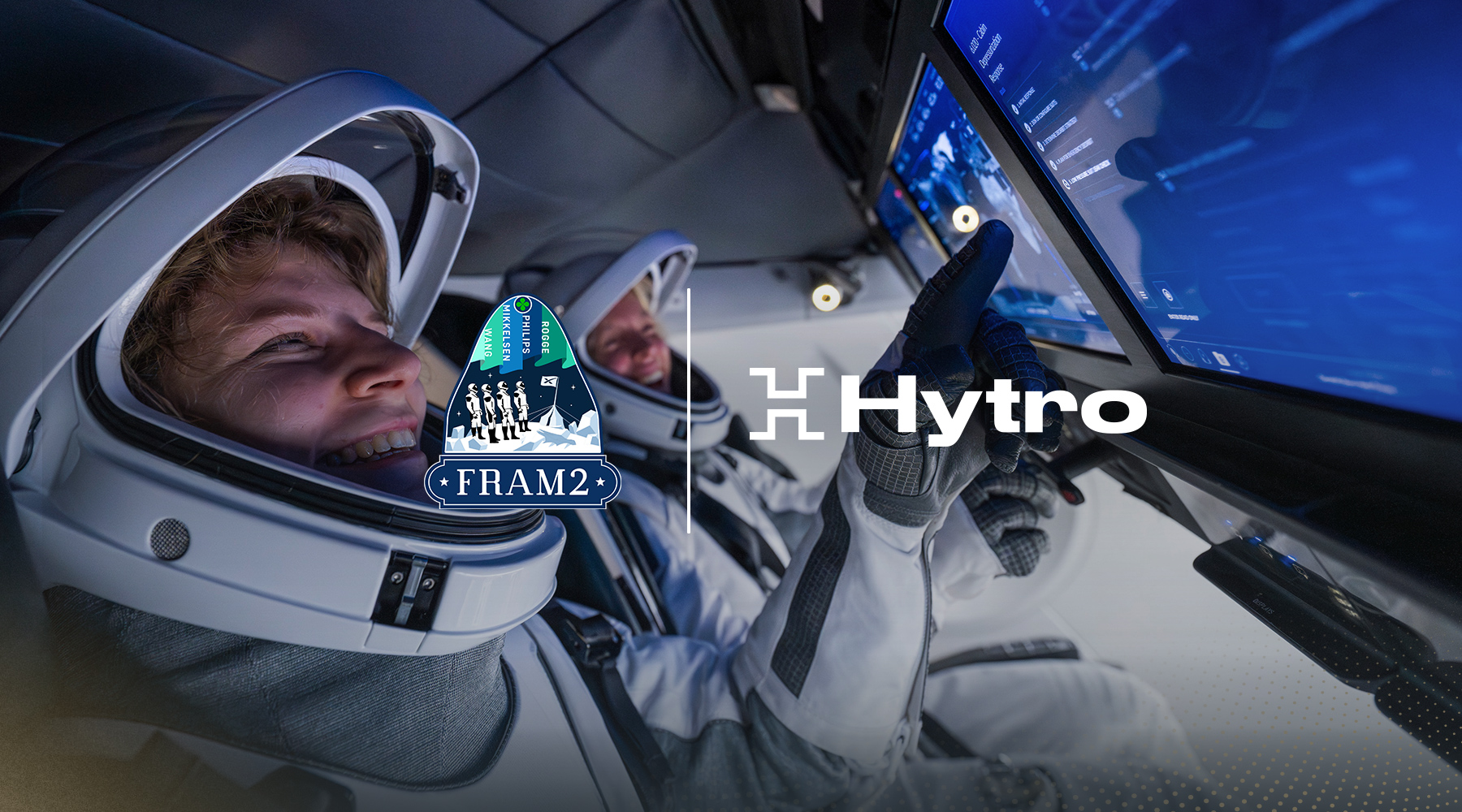Blood Flow Restriction Goes To Space With Hytro and Fram2
March 28, 2025

FRIDAY 28TH MARCH 2025 /ENDURANCE SPORTSWIRE/ – The Fram2 mission, the first human spaceflight over the Earth’s polar regions, is breaking new ground in space exploration by incorporating Hytro’s innovative Blood Flow Restriction (BFR) technology and Delfi’s Personalised Tourniquet System (PTS) for BFR technology.
This pioneering study is set to assess the safety and effectiveness of BFR during exercise in space to protect astronaut health in microgravity.
This marks the second phase in an ambitious program to examine the physiological benefits of BFR in space, following its debut on the Polaris Dawn mission in 2024. Hytro, a leader in wearable BFR technology, is spearheading this initiative in collaboration with the Advanced Wellbeing Research Centre at Sheffield Hallam University, Northumbria University’s Aerospace Medicine and Rehabilitation Laboratory, Delfi Medical Innovations Inc. and space technology leaders Vast and Labfront.
Fram2 is the first human spaceflight mission to a polar orbit, traveling over Earth’s North and South Poles. From an altitude of 425–450 km, the international crew of four will spend three to five days on-orbit, conducting research that advances human health.
Fram2 will be taking Hytro’s patented BFR wearables and Delfi’s PTS for BFR to bring the transformative benefits of BFR training to astronauts. The research builds on the proven success of Hytro with over 200 elite sports teams worldwide trusting the methods across the Premier League, NFL, NBA, NHL, with individual athletes in F1, boxing, athletics, and cycling.
The Advanced Wellbeing Research Centre at Sheffield Hallam University is a state-of-the-art facility dedicated to improving population health and wellbeing through innovative research, technology development, and collaboration with industry and healthcare partners. Their work with Fram2 and Hytro will see them lead on reviewing research and presenting findings of how BFR with exercise can protect astronaut health in zero gravity.
Supporting the mission will be crucial work from a number of other organisations including the Aerospace Medicine and Rehabilitation Laboratory at Northumbria University who focus on advancing research in human health and performance in extreme environments, such as space, and provide leading expertise on prescription and application of BFR exercise. Alongside them will be Vast – a pioneering aerospace company focused on developing space stations to support human habitation and research in space, with the goal of enabling sustainable space exploration and advancing humanity beyond Earth. Completing the collaboration will be Labfront – a health data analytics platform that helps researchers and organizations collect, analyse and manage physiological data from wearable devices and mobile health technologies to gain actionable insights for studies and projects.
Blood Flow Restriction, or BFR, works by applying a compression around the top of the thigh or arm to temporarily reduce blood flow to the muscles, which increases muscle stress, and ultimately enhances the impact and efficiency of exercise. This method enhances muscle strength and recovery more efficiently than traditional techniques. In microgravity, where there is no resistance to everyday movement, BFR could become an essential tool for maintaining muscle mass and bone density in space, potentially addressing a critical challenge for astronaut health. This collaboration provides a unique opportunity for the expertise developed in professional sports to be translated into space, providing a potentially powerful tool to preserve the health of future astronauts in the demanding conditions of space.
Fram2 builds on the success of the Polaris Dawn mission, where Hytro’s passive BFR technology was shown to be safe in microgravity. This second study introduces exercise with BFR, using ultrasound probes and wearable devices to analyse blood flow. The data will be compared to baseline measurements taken on Earth to better understand the effects of zero gravity on circulation.
The astronauts will exercise using a custom device developed by Vast that enables exercises such as squats in zero gravity. The findings from Fram2 will shape future studies on how BFR can combat muscle and bone deterioration, reduce fluid shifts to the head, and simulate low-level Earth-like activity in space.
Dr. Joe Handsaker, Co-Study Lead & Chief Innovation Officer at Hytro, stated, “This study is a massive step not just for Hytro but also the wider BFR community. By proving that BFR is safe to perform not only passively, as we saw on Polaris Dawn, but also whilst performing exercise, this will unlock the next stage of space research where we will be able to look at whether BFR improves exercise efficiency as much in micro-gravity as it has been shown to do here on earth.”
Dr Tom Maden-Wilkinson, Co-Study Lead Sheffield Hallam University & Emles Bioventures says, “As co-principal investigator for the project alongside Dr Joe Handsaker it is a real privilege to be able to be able to work as part of such a pioneering programme of research building on the success of our work on Polaris Dawn. Our ability to maintain our muscle mass and function is crucial not only for spaceflight but for our everyday lives. In bringing together experts from different fields of industry and academia, we hope that this work helps bring us ever closer to some of the solutions that will enable the aim of humans going to Mars.”
Raj Thiruchelvarajah, CEO and Co-Founder of Hytro, added, “It’s incredible to think that a conversation with NASA just one year ago has led to Hytro playing a leading role in pioneering BFR research in space. It’s a testament to our agile approach and innovative mindset.”
Dr. Warren Bradley, Founder and Head of Elite Performance at Hytro, emphasiSed, “This project challenges the boundaries of BFR research, taking it beyond traditional sports and clinical settings to explore its potential in extreme environments like space. It’s an exciting time for the entire BFR community.”
Dr Luke Hughes, Associate Professor of Aerospace Physiology and Rehabilitation at Northumbria University, highlighted, “BFR has been shown to improve exercise efficiency in ground-based studies in a manner which would be compatible with the greater constraints of exploration-class missions to space. This study marks the second in-flight research to explore the safety of BFR training as an adjunct to astronaut health and performance in space.”
For more information about Hytro and BFR, visit www.Hytro.com.
-ENDS-
What is BFR?
Blood Flow Restriction, or BFR, works by tightening a strap around the top of the leg to temporarily contain blood in the muscles while performing light exercise or recovery routines. This increases the stress on the muscle, causing them to repair more effectively, enabling users to get the same benefits while exercising at lower intensities or for shorter periods.
Why BFR?
Without gravity, muscles waste and bones weaken, leading to serious issues both in space and upon return to Earth. Therefore, regular exercise is a key aspect of life in space for astronauts. BFR has been shown to maximise the impact of exercise, and NASA is intrigued by its potential to maintain muscle mass and strength in microgravity, where traditional exercise equipment is not feasible due to size and resource constraints. Hytro is performing a series of studies in space alongside scientists from Sheffield Hallam University and data analysis experts from Labfront.
Why Hytro?
Traditional pneumatic BFR technologies require expert supervision and are considered a potential fire risk in high oxygen environments, making them unsuitable for space. Hytro’s BFR technology, unlike pneumatic options, is passive, provides optimal pressures, and is built directly into clothing. This enables astronauts to safely perform BFR while travelling and working in space without supervision.
Hytro shorts are pressure-validated to ensure that when tightened to the maximum level, they exert a safe and effective pressure range of 65-75 % LOP as identified by the BFR research community and are pressure limited to below 80% occlusion.
The Research Program:
The research program consists of multiple studies in space to assess how differing levels of Blood Flow Restriction impact various aspects of health. The first study will use ultrasound probes and smartwatches to examine how BFR affects blood flow in space and compare this to data captured pre-launch to better understand the lack of gravity’s impact on BFR.
Follow-up studies will examine the impact of BFR on muscle and bone health, which deteriorate in zero gravity. Future studies will explore other benefits, such as reducing dangerous fluid shifts to the head and simulating low-level activity similar to walking on Earth.
Long Term Ambition:
The long-term ambition is for Hytro’s strap-in technology to be integrated into all astronauts’ clothing as part of the Artemis III Mission to establish a lunar base on the Moon, a key step towards establishing a base on Mars.
About Hytro:
Hytro’s patented wearables package the remarkable benefits of BFR to improve performance. Extensively tested by experts, Hytro is ideal for active or passive work, allowing athletes and coaches to Prepare, Train, and Recover to the highest standards. Built on extensive scientific research, Hytro’s wearable BFR is made from high-quality fabrics chosen for comfort, performance, and longevity. It features a unique built-in strap, designed to deploy within seconds and ensure a safe and effective workout.
Contact:
Matt.williams@keepcomms.com
07818364184




